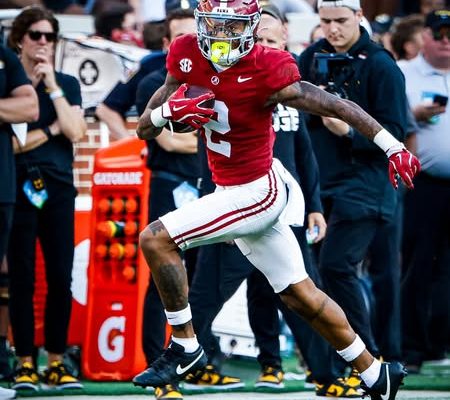In a college football world increasingly defined by specialization and scheme-specific roles, there still exists a golden standard—a symbolic torch passed from one all-around great to the next. That torch is known as the Paul Hornung Award. Named after the late Paul Hornung, the legendary “Golden Boy” of Notre Dame and the Green Bay Packers, this prestigious honor has become the ultimate tribute to the player who best embodies the spirit of complete football excellence. With every season, it underscores the enduring legacy of versatility and impact, placing a spotlight on players who not only play multiple roles, but who do so with dominance, intelligence, and unrelenting competitive fire.
The Paul Hornung Award was created in 2010 by the Louisville Sports Commission with the explicit aim of celebrating the most versatile player in major college football. But to merely call it an “award for versatility” is to vastly understate its significance. In a game where stars are often defined by stats in one dimension—quarterback rating, rushing yards, sacks, or receiving touchdowns—this award seeks the athlete who transcends position labels and impacts the game on offense, defense, and special teams alike. It’s a throwback in the most modern of senses, elevating the value of being a complete football player in an age of analytics and positional silos.
Paul Hornung himself was the ideal model. He played quarterback, halfback, fullback, placekicker, and even lined up on defense when needed. He won the Heisman Trophy in 1956 for a Notre Dame team that went just 2-8—a testament to how valuable and multi-dimensional his impact was. Later, as a Green Bay Packer under Vince Lombardi, he became a cornerstone of a dynasty, helping the team to multiple championships and earning NFL MVP honors. He could run, throw, catch, block, tackle, and kick—and he did it all with the grace and ferocity of a player who simply refused to be limited by a title on the depth chart.
In that same spirit, the Paul Hornung Award honors college athletes who are asked to do more, and who accept that challenge with pride. These players might be listed as running backs but line up in the slot as receivers. They might be wideouts who take direct snaps, or defensive backs who contribute to special teams as punt returners, gunners, or even coverage backs in emergency defensive packages. Each recipient becomes a chapter in the larger story of football’s most complete athletes—game-changers who exist at the very intersection of talent, adaptability, and leadership.
Year after year, the list of nominees reflects the changing face of college football. Offensive coordinators get more creative with their play-calling. Defensive players are asked to cover more ground and show more range. And special teams becomes an area where hidden stars shine brightest. As the season progresses, fans begin to notice that the most electrifying players are often the ones who show up all over the stat sheet—racking up yards on the ground, through the air, and in the return game. Some even contribute in defensive formations. These are the athletes that make the Paul Hornung Award watchlist so fascinating to follow.
When a player wins the Paul Hornung Award, it’s not just a testament to their athleticism. It is a nod to their football IQ, their willingness to put the team first, and their ability to step up whenever and wherever they’re needed. It says they are the kind of athlete who is trusted to make an impact no matter the situation, the formation, or the moment. That recognition is rare in a sport increasingly obsessed with metrics tailored to narrow roles. It’s about heart, hustle, and a hunger to never be defined by limits.
Past recipients include some of the most dynamic and beloved players in recent college football history. Names like Christian McCaffrey, who dazzled at Stanford with his mind-blowing all-purpose yards; Jabrill Peppers, the Michigan phenom who played linebacker, safety, wildcat quarterback, and return specialist; and Rondale Moore, the Purdue dynamo who seemed to teleport from one end of the field to another. Each of them left an indelible mark not because they were the best at one thing—but because they could be counted on to do everything.
The award ceremony itself is a prestigious event held in Louisville, Kentucky—Hornung’s hometown—and serves as more than just a trophy presentation. It is a celebration of football’s most dynamic traditions. Families, coaches, fans, and media gather to recognize not just raw statistics but the intangibles: work ethic, leadership, and fearless versatility. Attendees are reminded that football greatness is not always about flashy headlines—it’s often found in the gritty, tireless performers who change the outcome of games by refusing to be boxed into a single category.
The 2025 college football season has once again brought a thrilling group of candidates into the spotlight for this award. While the Heisman chase may focus on quarterbacks and the Biletnikoff may center around wide receivers, the Hornung Award quietly honors the soul of the game—the player who will take a handoff, then run 25 yards on a kickoff return, then haul in a 30-yard catch down the sideline, and perhaps even throw a block that springs a teammate for the game-winning score. They don’t need the ball on every down. They just need a moment—and when it comes, they make it count.
Coaches especially appreciate the type of player that wins the Paul Hornung Award. These are the glue guys, the chess pieces, the ones who allow coordinators to open up the playbook and keep opponents guessing. They thrive in chaos. They thrive under pressure. And most of all, they love the game—not for the stardom, but for the opportunity to contribute in every conceivable way. They’re often team captains, locker room leaders, and the first in the weight room. The award recognizes this deeper value, the player who is a Swiss Army knife of football greatness.
It is worth noting that the criteria for the Paul Hornung Award are strict. Players must exhibit outstanding performance in multiple roles and must show a significant impact in more than one phase of the game. This isn’t about being occasionally used on special teams. It’s about owning each role, excelling at each position, and creating measurable influence on the game’s outcome from multiple angles. Every carry, catch, return, and coverage moment must mean something—and the winner is the one who consistently delivers.
The award’s namesake, Paul Hornung, passed away in 2020, but his legend lives on in every athlete honored in his name. More than an NFL Hall of Famer, Hornung was the archetype of the multi-talented football hero. He once scored 176 points in a single 12-game season, back when touchdowns were just six points and kickers wore leather helmets. His style of play was fluid, creative, and relentless. He wasn’t playing for highlight reels. He was playing to win—and to do whatever needed doing on every down. Today’s winners follow in those footsteps, wearing their own numbers, yes, but carrying Hornung’s spirit in every yard gained.
In a broader sense, the award also stands as a philosophical statement. In a sport driven by scouting reports, combine drills, and hyper-focused positional drills, it reminds us that the greatest athletes are often those who break the mold. They don’t fit neatly into categories because they redefine what a category can be. In an era where “versatile” is sometimes used to mean “jack-of-all-trades, master of none,” the Paul Hornung Award reclaims that term to mean exactly what it should: the master of many, the MVP of flexibility, and the ultimate football force multiplier.
The conversation around the Paul Hornung Award has also begun to affect how NFL scouts evaluate prospects. Increasingly, players who are able to perform in multiple roles at the college level are seen as assets in the pros—not just for their physical abilities, but because of their football intelligence and adaptability. Special teams coordinators salivate over these kinds of talents. Offensive and defensive coordinators love the options they provide. It’s no longer enough to be good at one thing. If you can catch, run, cover, return, block, and improvise on the fly—you’re gold.
As the 2025 season winds toward its climactic conclusion, the spotlight on the Paul Hornung Award grows brighter. Analysts are poring over film, looking for those athletes who pop off the screen for more than just one skill. Fans are watching, often realizing that their team’s most important player may not be the one under center—but the one doing everything else. And future recipients are grinding through practice reps, knowing that every snap in every phase of the game is a new opportunity to earn recognition not just as a specialist—but as a complete football warrior.
In the end, the Paul Hornung Award isn’t just about stats or splashy plays. It’s about heart. It’s about a legacy of unselfish greatness. And most of all, it’s about honoring the athletes who still play the game the way it was meant to be played—with joy, with grit, and with the unwavering belief that no role is too small and no responsibility too big. That’s the spirit of Paul Hornung. And that’s what makes this award one of the most meaningful honors in all of college football.



